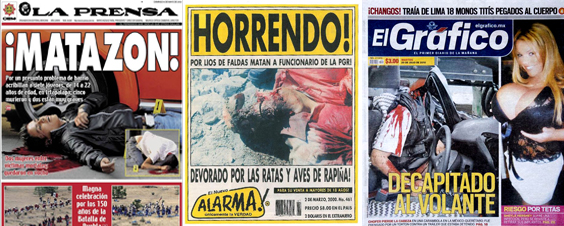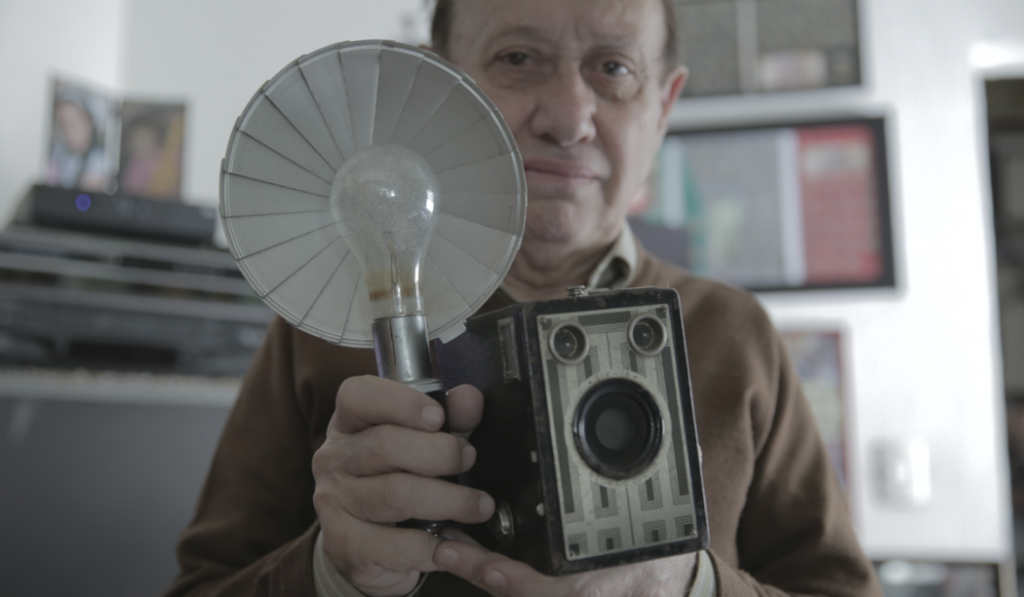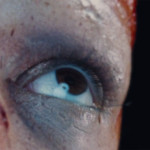Hot Docs 2016: “THE MAN WHO SAW TOO MUCH”
North America has its share of sensationalist tabloids – from the celebrity-obsessed to the sasquatch-obsessed – but none comes close in shock value to their Mexican counterparts, which give death the cover treatment in blood-red colour. I first heard of Mexican tabloids via Jim Goad’s eye-opening article “!MUERTE! Mexican Murder Mags Let It Bleed” in Answer Me! #2 (July 1992) – after which my first film festival CineMuerte and corresponding fanzine were named. “If homicide equals entertainment, the Mexican murder mags are the hardest-working zines in show biz,” wrote Goad. “In their brutal, gore-venerating implication that dying brings us all together, they constitute the true alternative press.” But behind these unapologetic publications dedicated to death, sex and sports are the photographers, one of whom has his long, storied career examined in THE MAN WHO SAW TOO MUCH.
This award-winning documentary by photography curator Trisha Ziff follows retired Mexican photographer Enrique Metinides, now in his 80s, who spent over 50 years photographing accidents and crime scenes for Mexican tabloids. Through interviews and reproductions of his striking photos, the film conveys the inner life of a singular artist and his knack for capturing the private moments in gruesomely public spectacle.
 Despite accolades from interviewees like composer Michael Nyman, director Dan Gilroy (NIGHTCRAWLER) and a number of curators who count themselves as fans, Metinides had no intention of being an artist; even today he clearly looks at his practice as a compulsion rather than a conscious art. But the early influence of Mexican and American cinema combined with his father’s gift of a camera at a young age provided an obvious pathway for a kid with lone wolf tendencies. He was only eight years old when he photographed his first corpse, beginning a long career as a death specialist.
Despite accolades from interviewees like composer Michael Nyman, director Dan Gilroy (NIGHTCRAWLER) and a number of curators who count themselves as fans, Metinides had no intention of being an artist; even today he clearly looks at his practice as a compulsion rather than a conscious art. But the early influence of Mexican and American cinema combined with his father’s gift of a camera at a young age provided an obvious pathway for a kid with lone wolf tendencies. He was only eight years old when he photographed his first corpse, beginning a long career as a death specialist.
In a move that mirrored the beginnings of America’s Highway Safety Films Foundation – also notorious for their graphic portrayal of real accident footage – and despite his age and lack of formal training, the police gave the young hobbyist full access to crime scenes and morgues, letting him into taped-off areas to provide much-needed documentation. He would be 12 years old when he was first published in the tabloids, and within a year he had regular paid work.
Over the years Metinides would find himself documenting bus accidents, chemical explosions and homicides. One gallerist interviewed says he feels conflicted describing the photos as beautiful – in particular one magnificent snapshot of a woman hit by a car – but they are. The reason for this comes from Metinides himself, a highly empathic person in comparison to many others in his business who have to shut themselves off completely from the horror of what they see every day on the job. Like the others, he stays tuned to the emergency radio frequency 24/7 and chases accidents, but unlike his counterpart in NIGHTCRAWLER, his job as a photographer is intertwined with humanitarian goals; there are numerous pictures of him on the scene, taken by other photographers, which show him carrying victims to safety.
His sentimentality comes across further in the way he obsessively collects and catalogs not only his own photos but other newspaper photos he didn’t take, wishing – for example on 9/11 – that he had been there to take the photos himself. He also collects plastic frogs, ambulances and fire engines, which the film uses as humorous counterpoints to his photographical fixations. But these collections underscore his humanity; the uncertainty of life, reinforced by witnessing so much death – much of it senseless and accidental – is exorcised through the meticulous maintenance of his collected artifacts. Lining them up, cleaning and dusting them, admiring them in a way any collector can relate to.
Metinides also makes a distinction between the Mexico he photographed – largely accidents – compared to gang violence today which is not only more brutal, but more prolific. While the documentary is not specific about all the outlets he may have worked at as a freelancer, it seems he worked primarily for La Prensa, a daily paper which has its share of tragic photographs but is far from the worst out there – VICE’s hour-long 2012 documentary Alarma! Documenting Mexico’s Most Violent Crimes focuses on a now-defunct weekly tabloid founded in 1963 that thrives on much more graphic imagery, and with decidedly less photographical panache (David Alvarado, the crime photographer VICE follows, makes a brief appearance in THE MAN WHO SAW TOO MUCH). It is not hard to see why Metinides is the one to become the celebrated photographer among those in his profession.
Dan Gilroy, the director of NIGHTCRAWLER, points out that while America likes to hide its dead – ironic for a country built on and obsessed with violence – in Mexico the dead are front and center, a sentiment shared by Jim Goad in his Answer Me! article. “Death is woven into everyday life, an object of worship, a wistful reminder of faded glories,” says Goad. “Our neighbors to the south certainly aren’t more perverse than us, maybe just a tad more honest.”
+++
THE MAN WHO SAW TOO MUCH has its International Premiere at Hot Docs May 3 – 3:30pm (Hart House), May 5 – 9:45pm (TIFF Bell Lightbox) and May 7 – 12:45pm (Hart House). Info and Tickets here: http://boxoffice.hotdocs.ca/WebSales/pages/info.aspx?evtinfo=50850~edeed7b8-5598-4ac6-994a-ca71bc407bc4&epguid=1982376d-17a7-4bb4-9959-f38bb053d10d&
Further Reading:
MUERTE! Death in Mexican Popular Culture (Feral House) BUY HERE: http://feralhouse.com/muerte/
“!MUERTE! Mexican Murder Mags Let it Bleed” in Answer Me! #2 READ ONLINE HERE: http://www.jimgoad.net/goadabode/issue%202/muerte.html
Alarma! Documenting Mexico’s Most Violent Crimes (VICE Documentary, 2012) VIEW ONLINE HERE: http://topdocumentaryfilms.com/alarma-mexicos-most-violent-crimes/

 May 6, 2016
May 6, 2016  No Comments
No Comments












